
Air Cannon Remote Trigger
Sprinkler Valve Modification
WARNING: No Liability Is Assumed By The Developers Of This Website and All Literature Is Provided Second Hand, Use It At Your Own Risk!
Here are the step by step instructions from SpudFiles on how to modify a sprinkler valve to be used as a remote firing device for an air cannon.
The first thing that must be done in order to soup up a sprinkler valve is to buy the valve.

There is one major thing to consider when buying a valve, does it or doesn't it have a guide rod?
A guide rod is a small metal bar inside the valve that guides the diaphragm. I have found two different valves that don't have guide rods and are very simple to work with and soup up.
The first valve is a Rainbird 1” inline automatic sprinkler valve. The second valve, the one pictured above and through out this how to tutorial, is a Watermaster 3/4" inline automatic sprinkler valve.
These solenoid valves are great options for creating an air cannon firing mechanism. To make this work, you must fill both small holes in the solenoid port with epoxy (as shown here).
Once you have removed your cover you need to drill a hole in the center of it. You will be threading a 1/4" barbed hose adaptor into this hole.
This is what the top of your valve should look like after drilling the hole.
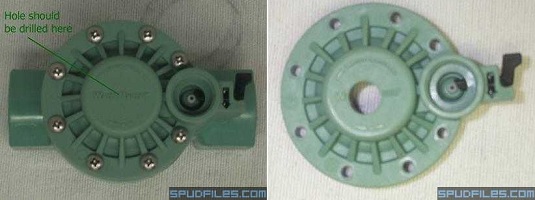
You can either use a 1/4" NPT pipe tap or you can simply drill a 1/2" hole and thread it with your fitting.
Make sure that the hole will not be in the way of the spring. If your valve has a guide rod, drill to the side of the cover but make sure that it isn't in the way of anything.
If you plan to use a 1/4" pipe tap, instead of the 1/2" hole, drill whatever size your tap recommends.
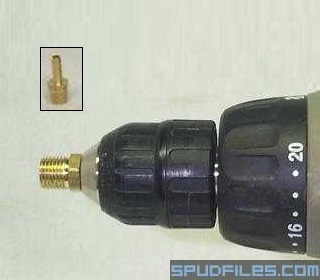 Now that your hole has been drilled you are ready to tap it for your fitting. If you
are using a pipe tap simply tap the hole and move on to the next step further below.
Now that your hole has been drilled you are ready to tap it for your fitting. If you
are using a pipe tap simply tap the hole and move on to the next step further below.
However if you don't have a pipe tap and are going to be threading the hole with your fitting you will need a drill and a 1/4" male barbed hose adaptor.
You now want to insert the hose adaptor into your drill chuck like this:
Now slowly and as straight at possible spin your adaptor into the hole.
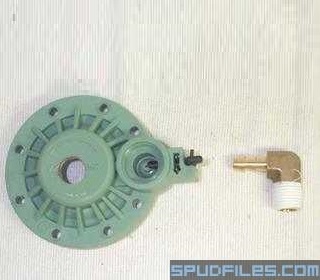 Once you have gone almost all the way, about 1/16” of threads still showing, stop. Remove
the adaptor from the drill chuck and then remove the adaptor with a crescent wrench.
Once you have gone almost all the way, about 1/16” of threads still showing, stop. Remove
the adaptor from the drill chuck and then remove the adaptor with a crescent wrench.
Once your adaptor has been threaded into your cover then removed, you may replace all parts inside your valve and screw the cover back down.
You will want to wrap the threaded end of the adapter with Teflon tape before screwing it back into your valve.
If you are going to be using the same adaptor that you used to tap the hole, you will also want to cover that in Teflon tap and thread it back in.
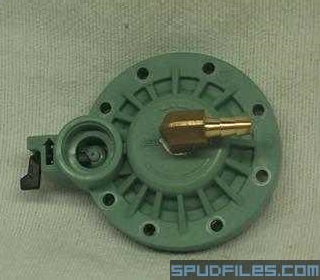 Once
you have threaded your fitting back into the valve cover it should look like this:
Once
you have threaded your fitting back into the valve cover it should look like this:
Once your adaptor has been threaded into your cover you may replace all parts inside your valve and screw the cover back down.
Your next step is to cut your hose to the desired length.
I have chosen to use 1/4" id by 1/2" of air hose. This is available at Mcmaster.com
After you cut your hose to the desired length you will want to add the attachments.
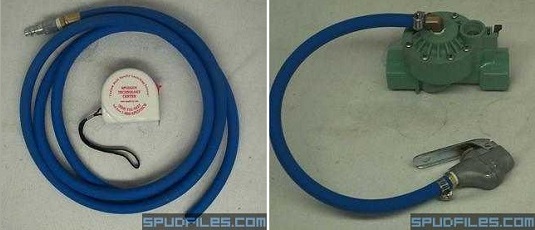
Insert one end into the barbed adaptor on your valve cover and the other end into a 1/4" male adaptor.
Secure both ends of hose with hose clamps.
Next, cover the threads of your male adaptor in Teflon tape and thread it into a blowgun rated for at least 100 PSI.
You are now all set to start using your souped up sprinkler valve.